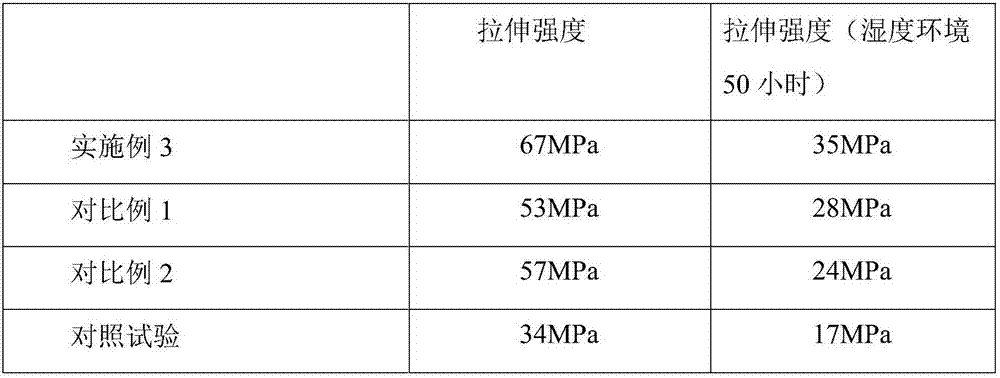Method for preparing sisal fiber-reinforced starch composite material
A composite material and sisal fiber technology, which is applied in fiber treatment, plant fiber, textiles and papermaking, can solve the problems of poor water resistance and poor mechanical properties, and achieve the effects of improving mechanical properties, facilitating processing, and improving water resistance
- Summary
- Abstract
- Description
- Claims
- Application Information
AI Technical Summary
Problems solved by technology
Method used
Image
Examples
Embodiment 1
[0021] A preparation method of sisal fiber reinforced starch composite material, comprising:
[0022] Step 1. Roll fresh sisal with a roller, wash it, put it in an oven at 180°C and stay for 100 seconds, take it out, put it in the first reaction kettle, add 2 times the volume of sodium hydroxide solution, and heat Boil and keep for 30 minutes, take out the sisal and wash it, put it into the second reaction kettle, add 2 times the volume of ethanol solution, pressurize to 500kPa and keep for 100 minutes;
[0023] Step 2, washing the sisal hemp obtained in step 1, drying, pulverizing, soaking with methyl methacrylate for 30 minutes;
[0024] Step 3, in parts by weight, mix 100 parts of starch, 80 parts of sisal obtained in step 2, 30 parts of polycarbonate, 10 parts of polycaprolactone, 1 part of nano-zinc oxide, and 0.5 part of azobisisobutyronitrile Evenly, the raw material mixture was obtained. First, the raw material mixture was heated to melt at a heating rate of 5°C / hour ...
Embodiment 2
[0032] A preparation method of sisal fiber reinforced starch composite material, comprising:
[0033] Step 1. Roll fresh sisal with a roller, wash it, put it in an oven at 180°C and stay for 150 seconds, take it out, put it in the first reaction kettle, add 3 times the volume of sodium hydroxide solution, and heat Boil and keep for 50 minutes, take out the sisal and wash it, put it into the second reaction kettle, add 3 times the volume of ethanol solution, pressurize to 500kPa and keep for 120 minutes;
[0034] Step 2, washing the sisal hemp obtained in step 1, drying, pulverizing, soaking with methyl methacrylate for 40 minutes;
[0035] Step 3, in parts by weight, mix 100 parts of starch, 80 parts of sisal obtained in step 2, 30 parts of polycarbonate, 10 parts of polycaprolactone, 1 part of nano-zinc oxide, and 0.5 part of azobisisobutyronitrile Evenly, the raw material mixture is obtained. First, the raw material mixture is heated to melt at a heating rate of 10°C / hour a...
Embodiment 3
[0043] A preparation method of sisal fiber reinforced starch composite material, comprising:
[0044] Step 1. Roll fresh sisal with a roller, wash it, put it in an oven at 180°C and stay for 120 seconds, take it out, put it into the first reaction kettle, add 2.5 times the volume of sodium hydroxide solution, and heat Boil and keep for 40 minutes, take out the sisal and wash it, put it into the second reaction kettle, add 2.5 times the volume of ethanol solution, pressurize to 500kPa and keep for 110 minutes;
[0045] Step 2, washing the sisal hemp obtained in step 1, drying, pulverizing, soaking with methyl methacrylate for 35 minutes;
[0046] Step 3, in parts by weight, mix 100 parts of starch, 80 parts of sisal obtained in step 2, 30 parts of polycarbonate, 10 parts of polycaprolactone, 1 part of nano-zinc oxide, and 0.5 part of azobisisobutyronitrile Evenly, the raw material mixture was obtained. First, the raw material mixture was heated to melt at a heating rate of 7°C...
PUM
 Login to View More
Login to View More Abstract
Description
Claims
Application Information
 Login to View More
Login to View More - R&D
- Intellectual Property
- Life Sciences
- Materials
- Tech Scout
- Unparalleled Data Quality
- Higher Quality Content
- 60% Fewer Hallucinations
Browse by: Latest US Patents, China's latest patents, Technical Efficacy Thesaurus, Application Domain, Technology Topic, Popular Technical Reports.
© 2025 PatSnap. All rights reserved.Legal|Privacy policy|Modern Slavery Act Transparency Statement|Sitemap|About US| Contact US: help@patsnap.com

